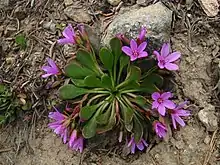Claytonia
Claytonia (spring beauty) is a genus of flowering plants native to North America, Central America, and Asia.[1] The genus was formerly included in Portulacaceae[1] but is now classified in the family Montiaceae,[2] primarily native to the mountain chains of Asia and North America, with a couple of species extending south to Guatemala in Central America, and northwest to Kazakhstan, Mongolia, and Russia in eastern Asia.
| Claytonia | |
|---|---|
 | |
| Claytonia virginica | |
| Scientific classification | |
| Kingdom: | Plantae |
| Clade: | Tracheophytes |
| Clade: | Angiosperms |
| Clade: | Eudicots |
| Order: | Caryophyllales |
| Family: | Montiaceae |
| Genus: | Claytonia L. |

The genus Claytonia was moved in 2009 from the purslane family (Portulacaceae) with adoption of the APG IV system, which recognised the family Montiaceae. A number of the species were formerly treated in the related genus Montia. A comprehensive scientific study of Claytonia was published in 2006.[3]
Claytonia perfoliata, the species for which the term miner's lettuce was coined, is distributed throughout the Mountain West of North America in moist soils and prefers areas that have been recently disturbed. The species got its name due to its use as a fresh salad green by miners in the 1849 Gold Rush in California.
Species
As of January 2019, Kew's Plants of the World Online lists 33 accepted species:[2]
- Claytonia acutifolia Pall. ex Willd.
- Claytonia arctica Adams
- Claytonia arenicola L.F.Hend.
- Claytonia arkansana Yatsk., R.Evans & Witsell
- Claytonia caroliniana Michx.
- Claytonia cordifolia S.Watson
- Claytonia exigua Torr. & A.Gray
- Claytonia gypsophiloides Fisch. & C.A.Mey.
- Claytonia joanneana Schult.
- Claytonia lanceolata Pursh
- Claytonia megarhiza (A.Gray) Parry ex S.Watson
- Claytonia multiscapa Rydb.
- Claytonia nevadensis S.Watson
- Claytonia obovata Rydb.
- Claytonia ogilviensis McNeill
- Claytonia ozarkensis John M.Mill. & K.L.Chambers
- Claytonia palustris Swanson & Kelley
- Claytonia panamintensis Stoughton
- Claytonia parviflora Douglas
- Claytonia peirsonii (Munz & I.M.Johnst.) Stoughton
- Claytonia perfoliata Donn ex Willd.
- Claytonia rosea Rydb.
- Claytonia rubra (Howell) Tidestr.
- Claytonia sarmentosa C.A.Mey.
- Claytonia saxosa Brandegee
- Claytonia scammaniana Hultén
- Claytonia serpenticola Stoughton
- Claytonia sibirica L.
- Claytonia tuberosa Pall. ex Schult.
- Claytonia udokanica Zuev
- Claytonia umbellata S.Watson
- Claytonia virginica L.
- Claytonia washingtoniana (Suksd.) Suksd.
References
- Flora North America
- "Claytonia L." Plants of the World Online. Royal Botanical Gardens Kew. Retrieved 11 January 2019.
- Miller, J. M. and K. L. Chambers. 2006. Systematics of Claytonia (Portulacaceae). Systematic Botany Monographs 78: 1-234. ISBN 0-912861-78-9
